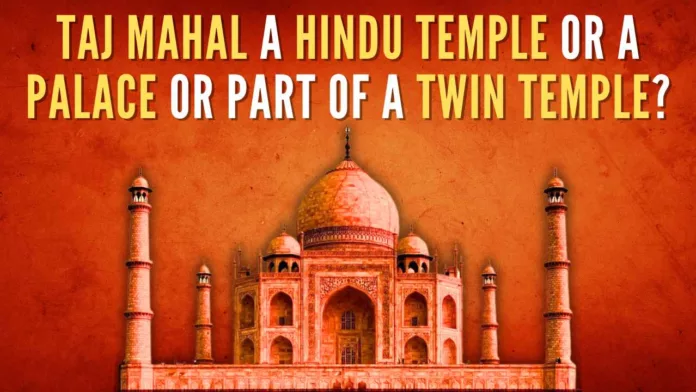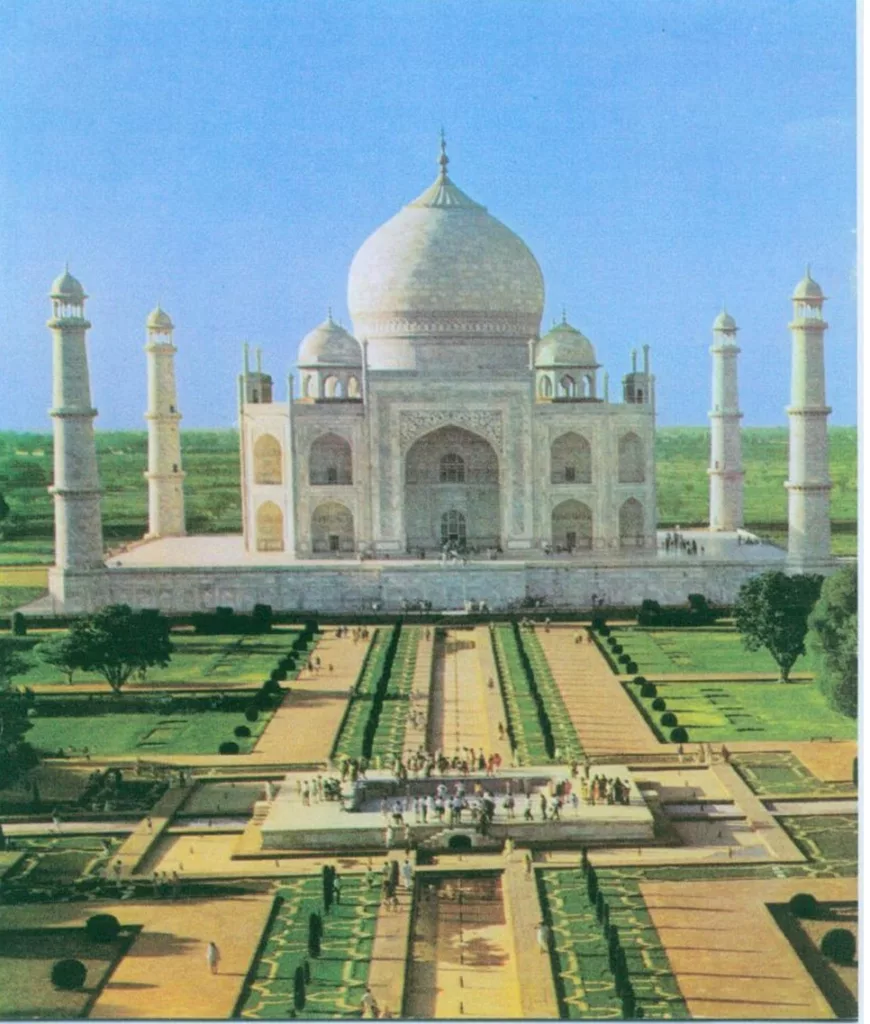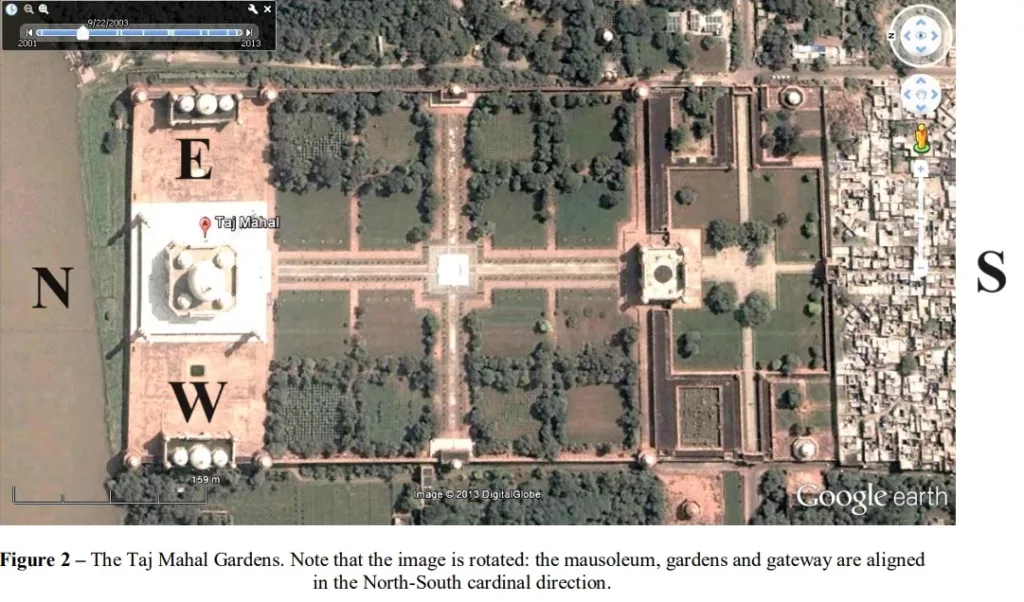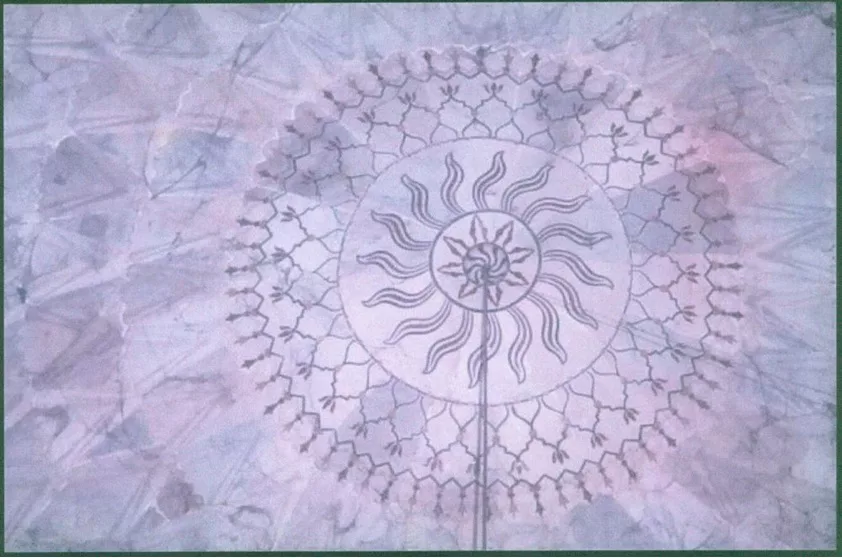
Revelations about the Taj Mahal
Recently the Delhi High Court directed the Archaeological Survey of India (ASI) to investigate a plea by Hindu Sena claiming that the Taj Mahal was not built by Shah Jahan. The plea was made to get the correct historical information about the age and construction of the Taj Mahal. This direction by the court generates a renewed interest in the antecedents of the Taj Mahal and a relook at the conflicting claims on its construction.
Stephan Knapp on his website has produced a list of articles by authors who claimed that the Taj Mahal was a pre-existing Hindu structure – either a palace or a temple – that was appropriated by Shah Jahan (reign 1628 to 1658) to house the last remains of his wife, Mumtaz who died during the delivery of her 14th child[1]. It was claimed that Shah Jahan employed 20,000 men who worked continuously for 22 years to complete the Taj Mahal. It is said that Mumtaz died in the year 1631, the work to construct the Taj Mahal commenced in 1632 and it got over in the year 1653. Several details about the authenticity of this claim and counterclaims can be read on Stephan Knapp’s website while here I would like to focus on less discussed or unpublicized issues only.
In any historical analysis, contemporary literature is accepted as primary evidence. Only two such texts exist as we know. One is the travelogue of J B Tavernier and another is Badshanama, an official biography written by chroniclers employed by Shah Jahan himself. Tavernier had written his work in French which was translated into English later. The English translation claims that he was present in Agra at the time of the commencement of the Taj Mahal and he returned when it was over. He asserted that the Taj Mahal was completed in 22 years with a manpower of 20,000 men.
A reading of his original version in French however showed that he came to Agra ten years after the year of commencement of the Taj Mahal and he was not in Agra at the time of completion. Therefore, whatever he had written was not firsthand information but something he wrote by hearsay. Hence, his version cannot be taken as primary evidence.
The only other contemporary work was Badshanama which contains vital information on the Taj Mahal. Of the total of 1600 pages, the information on Mumtaz and the Taj Mahal are found only in two pages. It says that the palace of Raja Man Singh which was in the custody of Raja Jai Singh was chosen for burying the late wife of Shah Jahan. Though Jai Singh was unwilling to part with his ancestral property he relented without expecting anything in return when the body of Mumtaz arrived. However, he was compensated with a piece of government land.
Badshanama says that in the following year, the body was buried under the dome. This makes it clear that there was a pre-existing structure which was used for burial. Here we must know background information about Raja Jai Singh. He was a subsidiary of Shah Jahan and fought for him in battles. His grandfather Man Singh whose palace was asked by Shah Jahan worked as a commander in the army of Akbar. During Akbar’s reign, Man Singh renovated the Kashi Vishwanath temple where Gyanvapi is located. Later this temple of Bhagwan Vishwanath was vandalized by Aurangzeb to build a mosque over it. But the temple was out of reach for the Mughals during Man Singh’s period.
Now examining the claims on the Taj Mahal as the palace of Man Singh got from the custody of his grandson Jai Singh to build the mausoleum for Mumtaz, it can be theorized that Jai Singh would not have let it into the hands of Shah Jahan if it was a temple. It is reasonable to assume that it was indeed a mansion that he gave up.
However, further developments raise doubts about the nature of the structure used by Shah Jahan. There are four extant Farman-s (orders) issued by Shah Jahan to Jai Singh to send stone- laborers, and cartloads of marble stones from the mines of Makranna. Jai Singh was reluctant to obey, and he delayed the dispatch of marbles and prevented the manpower from going to Agra to work on the mausoleum. Why did he do so? He handed over his palace in exchange for land, knowing very well the purpose for which it was going to be used. Having known that why did he not cooperate with Shah Jahan in getting the mausoleum finished in the way he liked?
Suppose the palace was not used for the purpose for which it was bought from him, and instead another site was used for the same purpose, there is scope to say that Raj Singh was upset with the new site used for burying. If the new site was a temple building, captured already by the Mughals, then Raj Singh could have had no say in how it was used. He would have been helpless. In that context, we can understand his reluctance to oblige the Farman-s of the Badshah.
This doubt arises from the numerous evidence cited by researchers like P N Oak and Dr. Godbole that the Taj Mahal could have been a temple. Certainly, Jai Singh did not give a temple for burying the corpse of Mumtaz; he had given only his palace. If there was a temple, he could be expected to have to protect it or renovate it like his grandfather who renovated the temple of Bhagwan Vishwanath. On the other hand, if a temple was already in the control of the Mughals, he had nothing to do about it. Perhaps to save the temple from becoming the mausoleum, he might have taken the difficult decision of giving up his precious ancestral property on the assurance that it would be used for housing the coffin of Mumtaz.
This looks feasible given the fact that he was hesitant to give his ancestral property. Only after the body arrived, he had reluctantly given up without expecting any returns on the assumption that the temple in the custody of the Mughals would be spared. But within a year the body was buried under the dome, says Badshahnama. Which dome? Where was the dome? Was that the dome of Man Singh’s palace or the dome of the temple?
In the latter case, there is a strong reason for the way Jai Singh was upset with the plans of Shah Jahan. He could not be expected to cooperate with him such that it required four Farman-s to be issued by the Badshah – they are the only evidence for the work of marbles done by Shah Jahan.
In support of the claim that the mausoleum was constructed on a pre-existing temple, let me quote a research work on the Mughal garden in the south of the Taj Mahal, called Charbagh. Square in shape, it occupies a larger area than the Taj Mahal area. It is crisscrossed by water channels to divide the garden into four equal squares. At the center, there is a fountain in existence right from Shah Jahan’s time. Water for this fountain is fed by an aqueduct from the Yamuna on the western side of the Taj Mahal and Charbagh. The aqueduct stops at the middle of the western side of the charbagh where water is kept in storage tanks. An earthen pipeline goes 6 feet under the ground from the middle of the western border to the center of the Charbagh to feed the fountain.
The fountain was bordered with marble slabs by Lord Curzon. Tourists and foreign dignitaries who visit the site used to sit on the marble slab to take snaps because the Taj Mahal is exactly behind this and can be captured in photographs in its entirety from this center.

The Charbagh was analysed by a researcher Dr. Amelia Carolina of Itay, whose findings offered a breakthrough in understanding what exactly existed in the site. In her paper ‘The Gardens of Taj Mahal and the Sun’ published in the International Journal of Sciences, dated Dec 2013, and made public in ResearchGate, she checked whether the Charbagh is aligned to the solstices[2]. And it was found to be aligned so!

The Taj is on the south of the river Yamuna and the picture we see of the Taj Mahal is aligned in North–South direction. The entrance of the Taj Mahal is facing west (not Mecca). In the above picture, the Charbagh region can be seen as a huge square with a central square met by the water lines in four cardinal directions, There are minarets on the four corners of the Charbagh.
Dr. Carolina found that the sun’s rays pass through the minarets in the northern corner on the day of summer solstice and the minarets in the southern corner on the day of winter solstice. In other words, the Charbagh is aligned to the direction of the solstitial sun. If so, the equinoctial sun will pass exactly above the central fountain. This is like how the equinoctial sun passes through the center of the Gopuram of the Ananta Padmanabha Swamy temple or Triplicane Parthasarathy temple and many temples of Bharat.

The limits of the solstices passing through the corners of the Charbagh are circled in the above picture. This alignment could not occur naturally but was measured over a year and marked. The solstices and the center where the equinox passes must have been marked, for what? Did the Mughals ever apply archeoastronomy to determine the site? Never. Not seen in Bharat.
The center in this scheme becomes a vital part because that is where something sacred must have been consecrated. What was there in the center originally?
The central alignment of the Charbagh with the equinox also means that the central dome of the Taj Mahal is aligned with the equinoctial path of the sun because it is exactly parallel to the center of the Charbagh. On the solstices, the sun passes through the corner minarets of the Taj Mahal too. This was not observed so far because we are not seeing the Taj Mahal in the east-west direction.
The alignment of the Charbagh shows that there was something sacred in that huge land which was ultimately destroyed by Shah Jahan. In this context, we have another piece of evidence too by means of a Sanskrit inscription that was supposed to have been removed from the Charbagh by Shah Jahan. Today it is in the Lucknow Museum.
Mr. D J Kale, an archaeologist had written the transcript of that inscription (known as Bateshwar inscription) in Epigraphia Indica. He has written,
“The said Munj Bateswar Edict was laid by King Paramardi Dev of the Chandratreya dynasty on Sukla Panchami in the month of Ashwin, in the year 1212 Vikram Samvat (or A.D. 1156). … King Paramardi Dev built two magnificent temples with white marble, one for Lord Vishnu and the other for Lord Shiva and they were desecrated later on by the Muslim invaders. Perhaps a farsighted man took the edict to a safer place at Bateswar and buried it beneath the ground”[3].
So, there were two temples, not just one temple at the site of the Taj Mahal built by King Paramardi Dev in the year 1156 CE. One was for Vishnu and another was for Shiva. The edict further states,
“He built a marble temple which is the abode of Lord Vishnu and the King bows down to touch His feet” (25). The King has built another marble temple which has been dedicated to the Lord Who has the moon as His ornament on His forehead and Who, getting such a beautiful abode, has forgotten to return to Kailash (26).” One of them was completely destroyed and the other was used to house the coffin of Mumtaz.
Paramardi Dev belonged to the dynasty which was known for having built the Khajuraho temples known for exquisite art and architecture. These two temples must have been exquisite with marble covering. These two temples must have been carefully aligned with the equinox and solstices. They must have been facing the western direction and the Murtis in the east.
They were captured soon after they were built because Paramadi Dev was defeated by the Ghurid general Qutb ud-Din Aibak around 1202–03 CE. Since then, Agra and the twin temples must have come under the control of the Muslims. No worship of the deities has been possible since then. As time went by the temples continued to be under the control of successive Mughal rulers of whom Shash Jahan seemed to have decided to use it for his own. Probably, Raja Jai Singh wielded an influence to desist him from using it. In that context, Shah Jahan might have hoodwinked Jai Singh in exchange for his ancestral property. No Rajput King would have liked to part with his precious ancestral palace. He was not willing, but the hidden intention of Shah Jahan to use the twin temples could have made him hatch a deal to offer his palace to bury the queen. But Shah Jahan faltered and used the temple to bury his wife. This angered Jai Singh who refused to cooperate with him.
This hidden scene looks plausible given the fact that the site is remarkably demarcated by archeoastronomy which is not a hallmark of Mughal architecture. Man Singh’s palace must have existed outside the Taj complex. A weak Jai Singh was duped into ceding his palace to the cunning Badsha thinking that he was saving the temple. This seems plausible because Jai Sigh was the grandson of Man Singh who protected the Kashi Vishwanath temple. Jai Singh would have wished to safeguard these temples too, but alas, they were already in the custody of the Mughals.
A fresh study of the archaeoastronomy of Charbagh and the Taj Mahal must be done to check the veracity of my claim. The Bateshwar inscriptions must be studied once again and the contents be published now because both these go hand in hand in proving that twin temples existed on the site. It is my understanding that the Charbagh housed the Shiva temple which was demolished. A ground penetrating study can reveal if the foundations of a temple are present underneath.
The Shiva temple was whitish in colour says the inscription such that Shiva preferred to stay here than in the snow-white Himalayas. This implies that the temple was covered with marble. The marbles were used for the other Vishnu temple which was converted into the mausoleum for Mumtaz. The image of the Sun on the underside of the dome of the Taj Mahal could mean that it was a temple of Surya Narayana.

When Shah Jahan ran out of marbles to cover the Mausoleum, he stripped some from the upper stories of the Taj Mahal and requisitioned some from Raja Jai Singh which he refused.
These revelations were spoken by me in PGurus you Tube channel which can be viewed here.
Note:
1. Text in Blue points to additional data on the topic.
2. The views expressed here are those of the author and do not necessarily represent or reflect the views of PGurus.
Reference:
[1] Taj Mahal: Was it a Vedic Temple? – The Photographic Evidence – Stephen Knapp.com
[2] The Gardens of Taj Mahal and the Sun – ResearchGate
[3] The Distorted History of Taj Mahal – Stephen Knapp.com
For all the latest updates, download PGurus App.
- Was Taj Mahal a Hindu temple or a palace or part of a twin temple? - November 13, 2023
- Does Agnihotra Homa offer protection from Corona Virus? - March 21, 2020
- Kejriwal owes his victory to MK Formula – the Coronavirus of Democracy! - February 14, 2020










